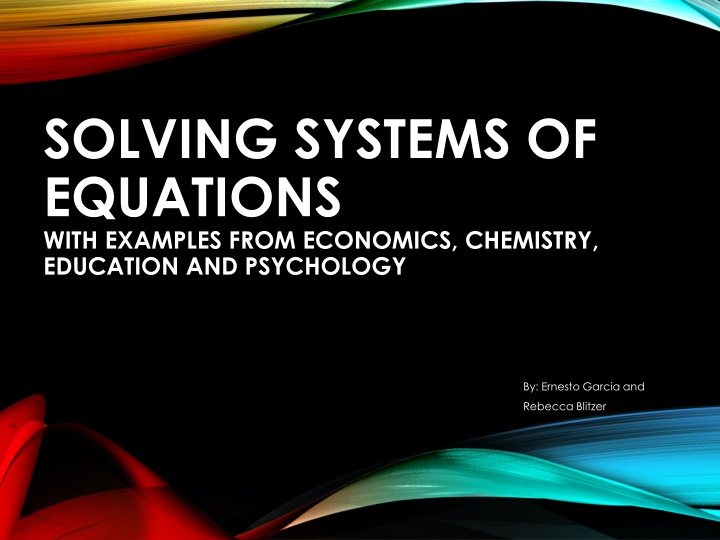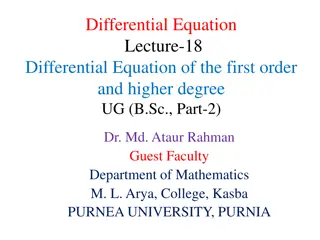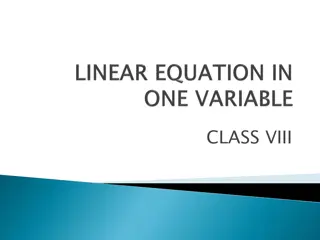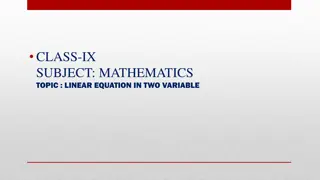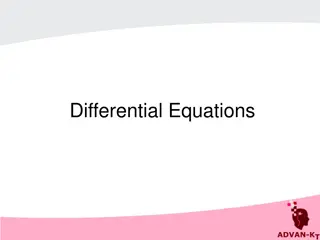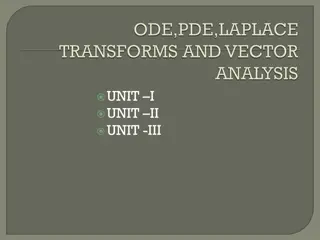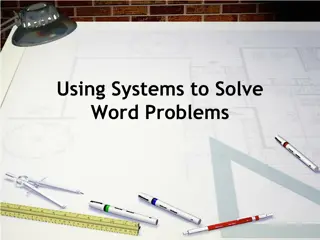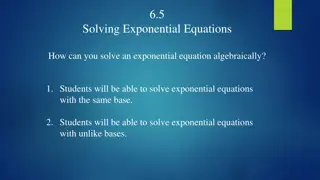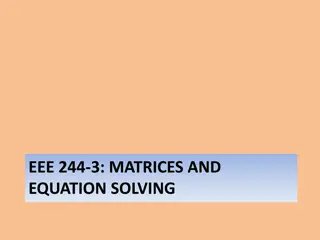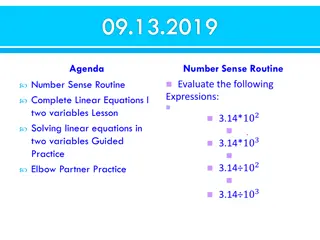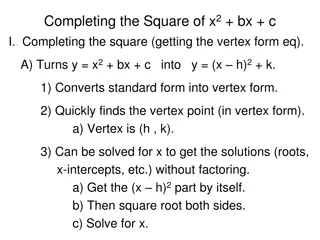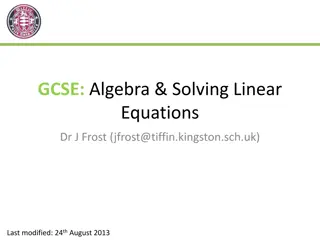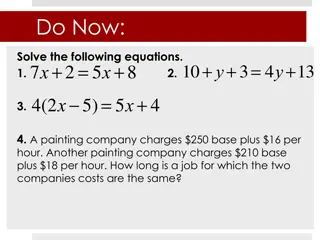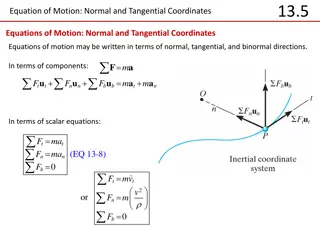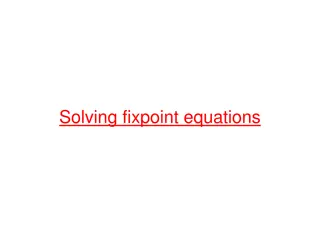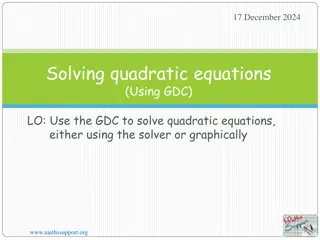Solving Systems of Equations: Basics and Examples in Various Fields
Understanding the basics of systems of linear equations and how to solve them is essential in various disciplines like economics, chemistry, education, and psychology. This content delves into the fundamental concepts of systems of equations, provides examples from different fields, and explains methods like substitution and elimination to find solutions. Explore how to solve systems of equations with practical examples and learn the underlying principles that govern these mathematical systems.
Download Presentation

Please find below an Image/Link to download the presentation.
The content on the website is provided AS IS for your information and personal use only. It may not be sold, licensed, or shared on other websites without obtaining consent from the author.If you encounter any issues during the download, it is possible that the publisher has removed the file from their server.
You are allowed to download the files provided on this website for personal or commercial use, subject to the condition that they are used lawfully. All files are the property of their respective owners.
The content on the website is provided AS IS for your information and personal use only. It may not be sold, licensed, or shared on other websites without obtaining consent from the author.
E N D
Presentation Transcript
SOLVING SYSTEMS OF EQUATIONS WITH EXAMPLES FROM ECONOMICS, CHEMISTRY, EDUCATION AND PSYCHOLOGY By: Ernesto Garcia and Rebecca Blitzer
SYSTEM OF LINEAR EQUATIONS A system of linear equations is a set of two or more linear equations that share some of the same variables. For example, ? = 3? 2 ? = 2? or 2? 5? = 1 7? ? = 3
HOW TO SOLVE A SYSTEM OF EQUATIONS If you have two equations and two unknown variables, then one of three things will occur: You will have a unique solution for the unknown variables (the lines represented by the equations intersect). You will have no solution (the lines represented by the equations do not intersect). You will have an infinite number of solutions (the lines represented by the equations are the same line).
There are two methods to solve systems of equations: substitution and elimination. With substitution, we solve one equation for a select variable in terms of the other variable. Then, that select variable is replaced in the other equation giving us an equation with just one variable. With elimination, we use one equation to eliminate a variable in the other equation which again leaves us with an equation with just one variable.
QUESTION 1 Solve for ? and ?. ? = 3? + 12 and ? = ? + 4. Solution: We have two equations and two unknowns. To solve, use the fact that both equations are solved for ?. Set the equations equal to each other and solve for ?: 3? + 12 = ? + 4 4? + 12 = 4 4? = 8 ? = 2
This system of two linear equations has one solution hence it must be that these lines intersect each other. The solution will be this intersection point. We know that the value for ? will be 2 at this point so we need to find what ? is. Since both lines share this point (they intersect at this point), we can plug ? = 2 into either equation and get the (same) value for ?. y= -3x + 12 y = x + 4 ? = 3 2 + 12 ? = 6 + 12 ? = 6 So the solution to this system is (2,6). ? = 2 + 4 ? = 2 + 4 ? = 6
QUESTION 2 Solve for ? and ?. ? + 3? = 5 4? 3? = 6 Solution: It is not immediately obvious how to solve this. We could use substitution by setting ? by itself on the left equation or ? by itself on the right equation. But let s try an example using elimination. ? + 3? = 5 4? 3? = 6 When we use elimination, we try to combine the equations through addition so that one of the variables is eliminated. If we combine these equations, the b terms will cancel out leaving us to solve for a. ? + 3? = 5 4? 3? = 10 5? = 5 ? = 1
Substituting for a in an original equation we can then solve for b. ? + 3? = 5 1 + 3? = 5 3? = 6 ? = 2 Our solution is a = 1 and b = -2.
In economics, there is a concept called equilibrium to which all the forces of nature are attracted. For supply and demand, the equilibrium price is a price such that quantity demanded will equal quantity supplied. In other words, the markets clear and there is no excess supply (left over goods) or excess demand (consumers are willing and able to buy the goods in question but are unable to due to unavailability).
QUESTION 3 Suppose demand is defined as P = 12 3??and supply is defined as P = ??+ 4. What is the equilibrium quantity? Solution: Let s first recognize that in equilibrium: ??= ??. Now we have two equations and two unknowns. We notice that both equations have ? by itself so set the equations equal to each other and solve for ?. 12 3Q = Q + 4 4? = 8 ? = 2 Now plug ? = 2 into either equation and we will obtain ? ? = 2 + 4 ? = 6
QUESTION 4 How many ounces of a 6% acid solution must be added to how many ounces of a 12% solution to produce 75 ounces of a mixture that is 10% acid? Solution: ? + ? = 75 0.06? + 0.12? = 0.10(75) Using substitution, we get: ? = 75 ? 0.06? + 0.12 75 ? = 7.5 0.06? + 9 0.12? = 7.5 0.06? + 9 = 7.5 0.06? = 1.5 ? = 25
QUESTION 5 Chemical equations an be balanced as in the following example. Beginning with the unbalanced equation ?? + ?3?? ??3?2?8+ ?2. The problem is to determine numbers of molecules of each of the four chemicals so that the equation will be balanced. We want w ?? + ? ?3?? ? ??3?2?8+ ? ?2, where w, x ,y, z are numbers of molecules of the respective compounds. (Remember that the subscript shows how many molecules already exist.) Equating the number of atoms of each elements gives Calcium: ? = 3? Hydrogen: 3? = 2? Phosphorus: ? = 2? Oxygen: 4? = 8?
Systems of equations are quite useful, as you have just seen. In the worksheet for this workshop, you get to work out more systems of equations and see more uses of systems of equations.
